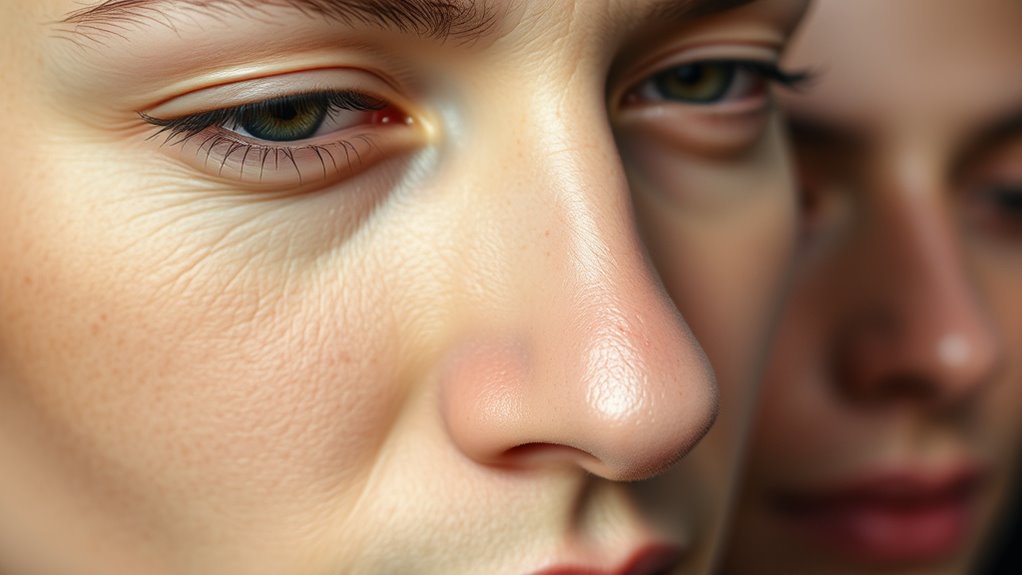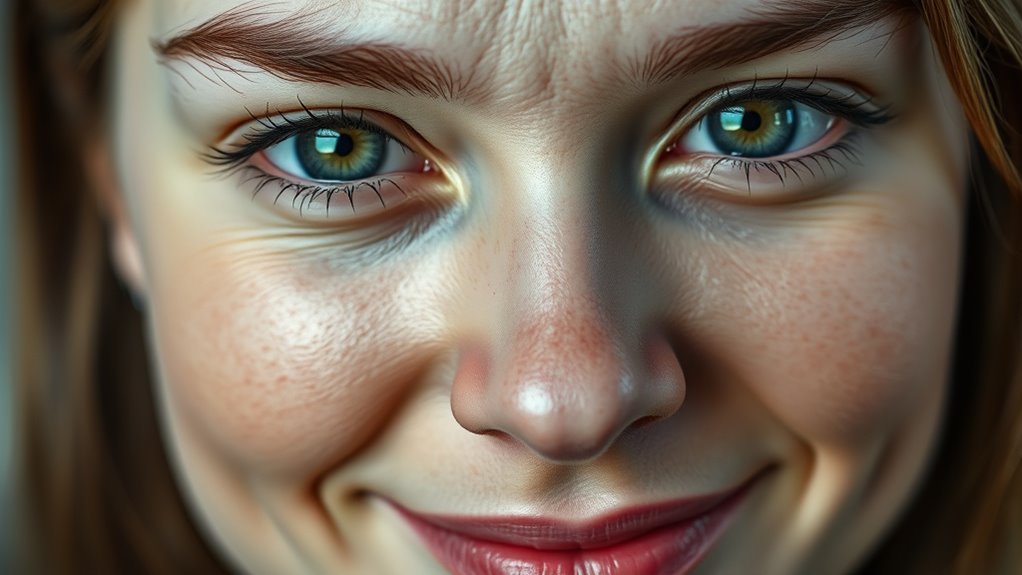Micro-expressions are quick, involuntary facial movements that reveal your true feelings in just a split second. By paying close attention to tiny cues like eyebrow raises, lip tensions, or flickers of emotion, you can gain insights into someone’s personality and genuine reactions. These fleeting signals often happen without conscious control, offering honest glimpses beneath surface appearances. Keep exploring these subtle cues, and you’ll uncover deeper insights into others’ authentic emotions and motives.
Key Takeaways
- Micro-expressions are involuntary facial movements that reveal genuine emotions quickly, often in less than a second.
- Recognizing micro-expressions helps uncover true feelings that may be hidden or concealed by others.
- Key micro-expressions include brief eyebrow raises, lip tightening, or forehead furrowing indicating specific emotions.
- Developing skills to read micro-expressions involves attentive observation and consistent practice.
- Understanding micro-expressions enhances communication by revealing authentic emotional responses and personality traits.

Micro-expressions are quick, involuntary facial movements that reveal genuine emotions beneath what people try to hide. These subtle shifts happen so fast—often within a fraction of a second—that most people don’t even notice them. But if you pay close attention, you can uncover a lot about someone’s true feelings by observing these fleeting emotional cues. Micro-expressions are like honest signals in body language, giving you a window into what’s really going on beneath the surface.
Micro-expressions are rapid, involuntary facial cues revealing true emotions beneath surface appearances.
When you watch someone’s face carefully, you notice small changes—perhaps a brief tightening of the lips, a quick raise of the eyebrows, or a fleeting furrow on the forehead. These movements are involuntary, meaning they’re not controlled or faked intentionally. Because of this, they serve as authentic indicators of emotion, whether someone’s feeling joy, anger, fear, or surprise. Recognizing these emotional cues requires focus and practice, but once you do, you gain a powerful tool for understanding others more accurately.
Your ability to read micro-expressions enhances your understanding of body language, helping you interpret what someone might be trying to conceal. For instance, someone may claim they’re happy with a decision, but a micro-expression might reveal a flicker of contempt or hesitation. This non-verbal information can be especially useful in high-stakes situations, like negotiations or interviews, where knowing someone’s true feelings can influence your response. You begin to see that body language isn’t just about gestures or posture; it’s also about these tiny, involuntary facial signals that speak volumes.
Paying attention to emotional cues requires you to be more observant and less distracted. Look for sudden facial movements that don’t match the person’s words or tone. Notice if their expressions flicker quickly, as these often indicate underlying feelings they might be trying to hide. For example, a brief smirk when discussing a sensitive topic might suggest sarcasm or disdain. Or a quick tightening of the jaw could hint at suppressed anger. Over time, these cues become clearer, and you develop an intuitive sense of what someone is really experiencing.
In essence, mastering the art of reading micro-expressions transforms your ability to interpret body language. It sharpens your perception, allowing you to see beyond words and surface-level signals. By focusing on these quick, involuntary facial movements, you gain insight into the authentic emotional state of others, making your interactions more genuine and effective. The key is to stay attentive and practice regularly—soon, you’ll instinctively pick up on these subtle emotional cues and better understand the people around you. Additionally, understanding My Dogs’ Names can teach you about consistent routines and care, which can also help you develop greater awareness of subtle cues in various contexts.
Frequently Asked Questions
Can Micro-Expressions Be Intentionally Controlled or Masked?
You might wonder if micro-expressions can be intentionally controlled or masked. While some people attempt emotional masking through conscious control, micro-expressions are often involuntary, revealing genuine emotions in a split second. Skilled observers can usually detect these fleeting signals despite masking efforts. So, although you can try to hide feelings, micro-expressions tend to expose true emotions that are hard to fully suppress, making them valuable in reading personality and intent.
How Accurate Are Micro-Expressions in Detecting Deception?
Did you know that lie detection through micro-expressions has about 54% accuracy? Micro-expressions can reveal emotional leakage that often exposes deception, but they aren’t foolproof. You should be cautious; some people can mask their true feelings, and others might involuntarily leak emotions. So, while micro-expressions offer clues, they shouldn’t be solely relied upon for detecting lies—context and other cues matter too.
Are Micro-Expressions Universal Across Different Cultures?
You might wonder if micro-expressions are universal across cultures. While some basic emotions like happiness or anger show emotional universality, cultural differences influence how expressions are displayed or interpreted. Non-verbal cues can vary, making it essential to take into account context. Recognizing these cultural nuances helps you better understand genuine emotions, but remember, micro-expressions aren’t flawless indicators of truth across all cultural backgrounds.
What Training Is Required to Interpret Micro-Expressions Effectively?
To interpret micro-expressions effectively, you need proper training techniques that enhance your interpretation skills. You should focus on exercises that improve your ability to notice fleeting facial cues quickly and accurately. Practice observing people in real situations, analyze video clips, and learn to distinguish genuine emotions from surface reactions. Consistent training helps sharpen your perception, making you more adept at reading micro-expressions in a split second.
Can Micro-Expressions Reveal Long-Term Personality Traits?
Micro-expressions can reveal some personality indicators, but they shouldn’t be relied on to determine long-term traits. Facial cues are often fleeting and context-dependent, making it hard to draw definitive conclusions about someone’s personality. You might notice certain micro-expressions that suggest underlying feelings, but these are more linked to momentary reactions than stable traits. Use them as clues, not absolute indicators of long-term personality.
Conclusion
Now that you understand micro-expressions, you can notice emotions, interpret truths, and connect deeply. Recognize fleeting signals, read hidden feelings, and improve your communication. With practice, you’ll spot sincerity, detect deception, and build trust. Micro-expressions aren’t just quick flashes—they reveal the real you and others. So, stay observant, stay curious, and keep honing your skills. Because, in a world full of words, sometimes it’s the briefest expressions that speak the loudest.









